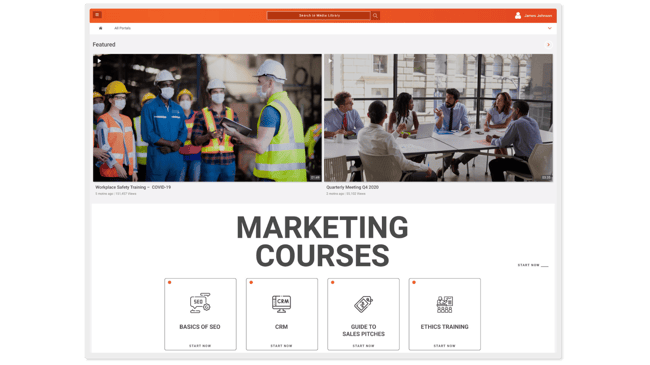How to Make Zoom Webinar Recordings Secure and Accessible On-Demand
by Nohad Ahsan, Last updated: August 21, 2025, Code:

Learn how to securely transform your recorded Zoom webinars and meetings into accessible on-demand videos. This guide will explore Zoom’s built-in features and why enterprise video platforms like Vidizmo offer a more secure, scalable solution for businesses.
In today’s fast-paced business environment, efficient communication is key, and Zoom has become a go-to platform for virtual meetings and webinars. But what happens when the meeting ends, and the content needs to be shared with those who couldn’t attend? The struggle to manage and securely share recorded Zoom meetings can be overwhelming for organizations, especially those handling confidential information.
Did you know? In 2025, Zoom will have over 300 million daily active users, a substantial increase from 10 million in December 2019. Studies show that almost 90% of businesses are now recording Zoom meetings for future use—yet only a fraction of them ensure these recordings are stored securely and easily accessible. This leaves companies vulnerable to security risks, compliance violations, and inefficiencies in sharing critical knowledge across teams.
For organizations facing these challenges, the need for a secure solution to transform Zoom webinar recordings into accessible video on demand is more pressing than ever. In this blog, we will guide you through the process of turning your recorded Zoom meetings into secure on-demand videos, explore Zoom’s built-in functionality, and discuss why using an enterprise video platform like Vidizmo offers a more secure and efficient solution for businesses.
This is why many organizations are on the lookout for a secure solution to make these Zoom meetings and webinar cloud recordings available as video on demand.
This blog will walk you through how Zoom helps make this possible. More so, we will detail how to make the best out of your recorded zoom meetings & what are the alternate solutions.
Making a Recorded Zoom Webinar On-Demand
If you’re wondering how to watch a recorded Zoom meeting, Zoom offers an on-demand webinar functionality, which allows you to schedule a webinar.
Once the webinar starts, it’s automatically recorded and stored on your Zoom Cloud. Any participants that register after the webinar has finished will receive a link to the recording instead.
Benefits of Zoom Webinar Recording
- Your message can be communicated to audiences who could not attend your webinar.
- The process is automated. All you need is to distribute one link that can be used to register, attend the event, and get a recording.
- Zoom also allows you to add custom fields to the on-demand recording request form, which you can use to capture leads’ contact information or acquire important information required for compliance purposes.
Limitations of Zoom Webinar Recording for On-Demand Videos

There are many limitations in maintaining the record for recorded zoom meetings as well as sharing Zoom webinar recordings in a secure environment and making Zoom webinars on-demand. Let’s have a look at a few:
- Zoom offers a basic video player that streams in only one format.
- Viewers with low bandwidth or devices that don’t support this format will face issues watching the recorded Zoom videos.
- Zoom has a minimal offering for limited sharing of your recorded meeting.
- You can only generate shareable links, password protect and set an expiration time.
- It doesn’t allow you to create a library of your recorded webinars, unlike a YouTube channel, where you can upload them for viewing.
- The Zoom video library is not the best for managing large recordings.
- You can’t create folders or playlists in the library.
- The search feature is very basic (only allows searching through transcript), and there are no filters.
- Zoom’s video player is not optimized for accessibility, which means that you can’t upload transcriptions.
- You can automatically generate closed captions but only through a third-party service.
- You do not have the functionality to attach audio descriptions or use keyboard shortcuts for navigation – these functionalities are required for Section 508, ADA and other accessibility compliances.
- Zoom doesn’t support collaboration once a meeting or webinar ends -viewers can’t add comments or ask questions after a webinar while watching the on-demand recording.
- Zoom doesn’t offer any embedding options for you to include these recorded Zoom meetings on your website.
Learn More About: How VIDIZMO Helps Solve Zoom Security Issues
Uploading Your Zoom Webinar Recording on YouTube
An alternate method to make your recorded Zoom webinars available as video on demand is to upload them on YouTube or Vimeo.
It is a good option if your webinars are public and you don’t have any GDPR compliance requirements to adhere to for recorded meetings. For instance, GDPR law requires you to limit the meeting recordings to “those with a need to know.” Here is more about GDPR and Virtual Meetings
Benefits of Using YouTube for On-Demand Zoom Webinar
- Your videos are indexed by Google and appear in search results, helping you reach out to wider audiences.
- YouTube’s video player is optimized for accessibility, with options to upload captions and keyboard shortcuts for navigation within the video.
- It provides you with a large potential audience to reach out to.
- You can create a library of your recorded Zoom webinars that your audiences can easily navigate through.
- You can engage with your audiences via comments.
- Users can also search for relevant topics once on your channel.
- You can embed recording videos from YouTube and share them on social channels.
Limitations of Using YouTube for On-Demand Videos
- Content uploaded on YouTube is public (viewable by anyone) and can be shared ahead indefinitely – an issue if you have to adhere to compliance requirements like GDPR.
- Once uploaded, you agree to allow YouTube to reproduce, create derivates of the content, and do much more – you won’t retain ownership of content.
- YouTube does not allow you to choose where to store your data – unlike a video content management system that allows you to store on Azure, AWS, Google Cloud etc., in the global data center of your choice (we’ll discuss these later in the blog).
- There are no rich sharing options, such as password-protected sharing, limited-time viewing, authenticated access for viewing and link expiration.
- There is no functionality to upload audio descriptions, which means it is not fully optimized for accessibility requirements, such as Section 508 compliance.
- You can’t restrict viewing or track viewing activity through logs – again a problem when it comes to fulfilling data protection compliances like GDPR.
Where video conferencing solutions and YouTube-like public video platforms fail, enterprise video platforms take charge.
Using an Enterprise Video Platform for Zoom On-Demand Videos
They are essentially a Video Content Management System but for enterprise video requirements.
Video CMS can be integrated with Zoom and other video conferencing solutions to create a private YouTube-like video library with all your meeting recordings securely stored for your organization only.
In addition, these platforms offer many other advanced AI-powered features to help resolve the issues that occur with YouTube and Zoom when it comes to sharing and managing webinars or meeting on-demand recordings.
Read More: How to Better Manage your Growing Zoom Cloud Recordings?
VIDIZMO is a key example of an effective AI-powered enterprise video platform for automatically ingesting recorded Zoom meetings and webinars to make them securely available as videos on demand in a brandable library.
Benefits of Using VIDIZMO Enterprise Video Content Management System
- You can upload and share your recorded webinars or meetings through a YouTube-like portal, which can be branded according to your liking.
- You can choose to store your videos on Azure, AWS, Google Cloud, On-premise, or any cloud and determine the geography of where you want to store your data.
- Different Video CMS providers offer storage in different clouds, but VIDIZMO gives you the flexibility to choose the cloud of your choice.
- You can define access for videos; who can watch them? How long can they watch them for? Can they download them?
- You can even restrict recordings to certain groups.
- You can securely share recorded Zoom meetings internally or externally.

- VIDIZMO offers audit logs within their application, unlike others requiring you to contact their customer support to get reports.
- It offers rich sharing options, such as password protection, link expiration and more.
- Videos are shared in end-to-end encrypted formats.
- VIDIZMO has AI capabilities to automatically transcribe and translate the transcription of your recorded meetings and webinars. It also helps in searching through your library by spoken words.
- You can use smart search to search by spoken words, on-screen text, faces and objects to jump to a particular point in the recording.
- It provides rich categorization options; you can create folders, categories and playlists. A sample categorization is shown below:

- You can stream recorded webinars as a live video, where they will be scheduled to run between a select time.
- VIDIZMO’s video player adheres to most accessibility requirements; keyboard shortcuts, transcriptions, closed captions, and audio descriptions.
- You can add interactivity elements inside videos such as quizzes with assessment reports, downloadable handouts or surveys.
- The video platform is collaborative with features like in-video annotations and comments.
- You can easily embed videos on your website or even embed with authentication required for access.
- Webinars uploaded are indexed on Google as well.
- You can also use the VIDIZMO EnterpriseTube to conduct your webinar, as these have low-latency live streaming capabilities.
An important thing to understand is that an EVCM is not just limited to sharing recorded webinars but can be used to fulfill multiple video challenges through one platform.
Hence, you can create a centralized video library for all your video content, from marketing videos to training content and meetings recordings. You can even conduct live events.
Key Takeaways
-
Zoom Webinar Recordings: Zoom allows you to record and make webinars available on-demand, but it has limitations in video management and accessibility features.
-
Challenges of Zoom: While Zoom's on-demand features provide basic functionality, they fall short in areas like security, accessibility, and video organization.
-
Enterprise Video Platforms: Platforms like Vidizmo offer enhanced security features, better video content management, and support for compliance with accessibility standards.
-
Vidizmo’s Advantage: Vidizmo provides a branded video library for your Zoom recordings, offering features like customizable video players, AI-powered search, and strict access controls.
-
Improved Security and Access Control: Unlike Zoom, Vidizmo ensures your content is secure with password protection, role-based access control, and audit logs, allowing you to manage who views your content and for how long.
-
Enhancing Accessibility: Vidizmo supports closed captions, transcriptions, and audio descriptions, ensuring your content is accessible and compliant with Section 508, ADA, and other standards.
-
AI-Powered Features: Vidizmo’s AI capabilities allow you to automatically transcribe and translate Zoom webinar recordings, improving searchability and user experience.
-
Better Organization: Vidizmo lets you categorize and organize your Zoom webinar recordings, create folders, and even add interactivity within videos, such as quizzes and downloadable handouts.
-
Take Action: If you're ready to make your Zoom webinar recordings secure, accessible, and easy to manage, explore Vidizmo's Enterprise Video Content Management System by starting a free trial.
Making Zoom Webinar Recordings Secure and Accessible On-Demand
In summary, transforming your Zoom webinar recordings into secure, accessible on-demand videos is essential for businesses that need to share critical information with remote teams or external audiences.
While Zoom offers basic functionality, platforms like Vidizmo EnterpriseTube provide a more robust solution with advanced security features, enhanced video content management, and compliance options.
By choosing the right video platform, you can ensure that your Zoom recordings are stored securely and are easily accessible without compromising on accessibility or data protection.
If you're ready to take control of your Zoom webinar recordings and explore how Vidizmo can enhance your video management, contact us or start a free trial today to see how we can help your business scale with secure video solutions.
People Also Ask
What are Zoom webinar recordings and how can I access them on demand?
Zoom webinar recordings are the videos of meetings or webinars hosted on Zoom, which can be accessed after the event has ended. To make them available on demand, you can use Zoom’s built-in on-demand webinar feature, where a recording link is provided to those who couldn’t attend the live session. However, for better security and functionality, using a platform like Vidizmo is recommended for storing and sharing these recordings.
How do I make a Zoom webinar available on demand?
To make a Zoom webinar available on demand, you need to enable the recording feature when scheduling your webinar. After the event, Zoom automatically stores the recording, and you can share a link with your audience for them to watch it later. However, Zoom’s on-demand video player has limitations, such as lack of advanced accessibility features and poor video management capabilities. An enterprise video platform can solve these challenges by offering enhanced features like customizable player, better security, and compliance options.
What are the benefits of using a Zoom video hosting solution for on-demand webinars?
A Zoom video hosting solution allows businesses to store and share webinar recordings securely. It helps manage video libraries and provides secure access control. While Zoom’s cloud offers basic storage and sharing, a dedicated video hosting solution provides enhanced features like password protection, detailed analytics, and better compliance with security standards. These solutions help ensure that sensitive webinars are shared with the right audience under secure conditions.
How can I create an on-demand webinar with Zoom?
Creating an on-demand webinar with Zoom involves recording the session during the live webinar and sharing the link afterward. While Zoom automatically handles the on-demand functionality, it does not offer features like categorization or advanced sharing options. Using a platform like Vidizmo helps you manage your webinar recordings, apply stricter security measures, and organize your videos in a branded, accessible library.
Can I make my Zoom webinar on-demand for a specific audience?
Yes, Zoom allows you to make your webinar on-demand by sharing a link with registrants or attendees. However, for better control, such as limiting who can view the recording or managing access based on specific user groups, you might consider using a dedicated Zoom video hosting solution. Platforms like Vidizmo allow you to set permissions and restrict access to particular user groups, ensuring secure and controlled sharing of your content.
How do I record a Zoom webinar for on-demand access?
To record a Zoom webinar for on-demand access, simply schedule your webinar with the recording option enabled. Once the webinar is over, the recording is automatically stored in your Zoom cloud. You can then share a link to the recording with those who missed the event. However, Zoom's default player has limitations in terms of security and user management, so using an enterprise video platform can provide better functionality and compliance.
What is a Zoom automated webinar and how does it work?
A Zoom automated webinar is a pre-recorded webinar that is set to run automatically at specific times, allowing attendees to view the content without the host being present. Automated webinars are useful for reaching a larger audience across different time zones. However, Zoom’s automated webinars can benefit from added features like interactive elements and security when hosted on a video platform like Vidizmo.
What is the difference between a Zoom webinar recording and a Zoom video webinar?
A Zoom webinar recording refers to the captured content of a live webinar that attendees can watch afterward. A Zoom video webinar, on the other hand, is a specific feature for larger audiences, where video and audio are streamed live. Both types can be made available on demand, but managing and sharing these recordings securely requires a robust video content management system.
How can I share Zoom webinar recordings securely?
To share Zoom webinar recordings securely, you can enable password protection and set expiration dates on the links. However, Zoom’s native options are limited. For more advanced security features, such as authenticated access and detailed tracking, consider using a Zoom video hosting solution or an enterprise video platform like Vidizmo that offers end-to-end encryption and access control.
What are the benefits of using an enterprise video solution for Zoom on-demand webinars?
An enterprise video solution for Zoom on-demand webinars provides advanced video management features such as categorization, customizable player options, and strict access control. Platforms like Vidizmo allow organizations to store and share webinars securely with compliance features, detailed analytics, and powerful search capabilities, making it an ideal solution for businesses with sensitive content.
Jump to
You May Also Like
These Related Stories

VIDIZMO | Alternative to VdoCipher for Secure Video Hosting

VIDIZMO and Wowza | A Ready-made Application for Live Video Streaming




No Comments Yet
Let us know what you think